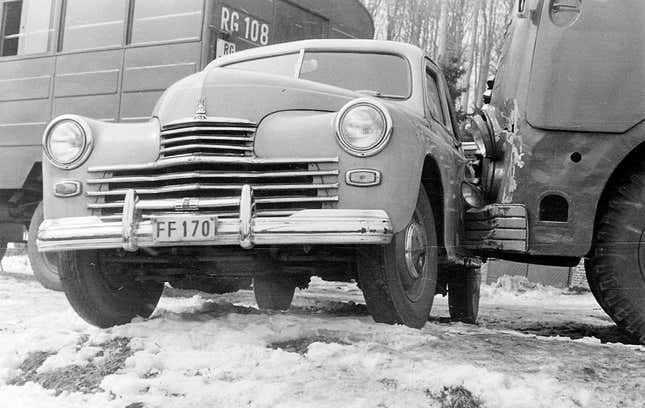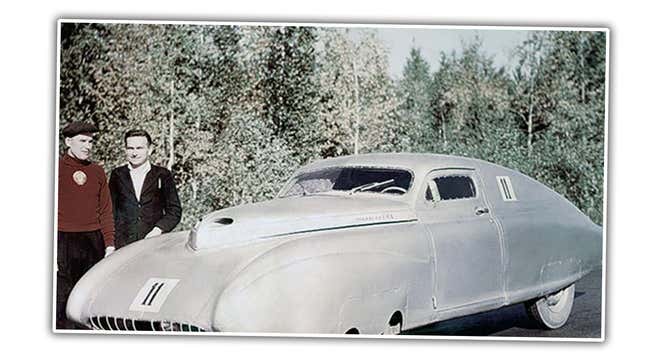We get emails all the time from people asking us to identify cars they encounter, and these are some of my favorite emails we get, after the ones scolding me for my toilet-mouth. We just got one today that caught my attention, both because of the car and the context: the context was a wine label, and the car was a strange Soviet teardrop-looking thing. I was curious.

The wine is from a grapes-brewery (I think that’s what they’re called) named Prototype Wines, and since I know Jack Feces about wine, I can’t comment about what it’s like.
But I do know weird cars, and the car on the label absolutely qualifies. It was familiar-looking, though, and I was certain I’d seen it before.
The somewhat awkward, uncertain look of the design suggested an origin from somewhere other than the usual suspects. Eastern European, it looks like. Was it one of those Skoda streamliners from the 1930s? No, it looks more post-war. Soviet?
Yes, Soviet.
Then I remembered that GAZ made some strange race cars after the war, and a bit of Googling later, I had my answer: that’s a 1950 GAZ Pobeda M-20 Sport.

The story behind the car is pretty interesting; after the war, there were a number of European sports cars that made their way into the Soviet Union, including some of the Auto Union mid-engined streamlined cars. These appropriated race cars were used in racing inside the USSR for a while, until a 1948 decree prohibited the use of foreign-built race cars in competition, meaning that domestic manufacturers had to pick up the slack.
Racing wasn’t a huge priority in the Soviet Auto industry, so not many resources were spared to develop cars, but there were some efforts, of which this car, the GAZ Pobeda M-20 Sport, is likely the first real successful one.
The drivetrain and basic chassis was taken from the normal M-20 Pobeda, a four-door family/general-use sedan built from 1946 to 1958 in the Soviet Union, and under license in Poland from 1951 all the way until 1973.

It was popular, finding a lot of use as taxis, and the 50-ish horsepower two-liter inline-four wasn’t exactly a screamer, but it got the job done. It wasn’t really the ideal platform for a racing car, but in the Soviet Union, you worked with what you had.
To turn the M-20 into the Sports version, there wasn’t that much done to the chassis, but the engine did get bored out to 2.5 liters and got twin carbs, giving it a substantial boost to 75 HP.
Still, that’s not a lot of horses, even stout Soviet ones, so more effort was spent on keeping it light and improving the aerodynamics. With that in mind, the GAZ designers came up with a body made of light duralumin, with skirted wheels and a dramatic elongated teardrop shape.

Protrusions were mostly eliminated, and the grille was reduced to a wide low intake and a couple of “nostrils” on the hood. The resulting car weighed 2,645 pounds, not bad considering the original was a tubby 3,218 pounds, and was capable of hitting 100 MPH, good enough to set some intra-Soviet speed records at the time.
Five cars were built, and this can really be thought of as the first real Soviet designed-and-built race car.
Okay, so now we know about the car—why and how did it end up on a wine bottle? Was there significance to the Soviet heritage? Did the winery even know what the car was?
To find out, I reached out to the company that designed the label for the winery, Vanderbyl Design. I spoke with Michael Vanderbyl, the owner, and asked if he knew what the car was. The answer?
Sorta.

Michael explained to me that the image was found in an old archive of Russian and Soviet photographs and clip art. The name “Prototype” was a tricky one for a wine, so Michael decided that an unusual, concept-looking car was something most people could associate with the word “prototype,” and so he set out to find something unusual and, ideally, unrecognizible.
That old Russian file provided just what he needed.
So, while he wasn’t sure of the specifics of the car, he knew it was Soviet, which also meant that the image didn’t really have an owner, since the entire country has been gone for decades.
A little bit of tweaking and reworking the image to get it to print well, and, boom, the Prototype wine label, complete with a strange, evocative car.
So, there you go, that’s how an obscure but important Soviet race car ends up on a wine bottle: by chance, mostly.
(thanks for asking, Wes!)